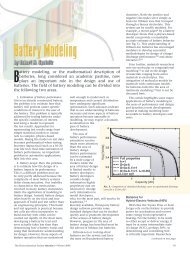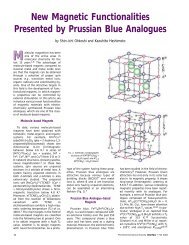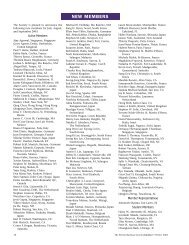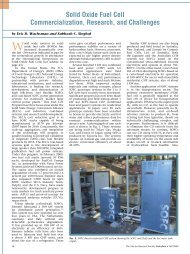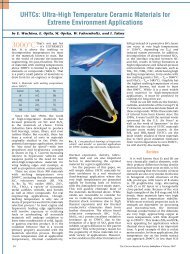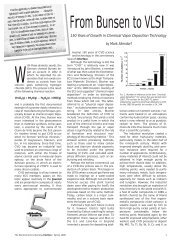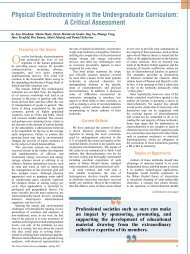Electrode/Electrolyte Interface Studies in Lithium Batteries Using NMR
Electrode/Electrolyte Interface Studies in Lithium Batteries Using NMR
Electrode/Electrolyte Interface Studies in Lithium Batteries Using NMR
Create successful ePaper yourself
Turn your PDF publications into a flip-book with our unique Google optimized e-Paper software.
<strong>Electrode</strong>/<strong>Electrolyte</strong> <strong>Interface</strong> <strong>Studies</strong> <strong>in</strong> <strong>Lithium</strong> <strong>Batteries</strong> Us<strong>in</strong>g <strong>NMR</strong><br />
by Nicolas Dupré, Mar<strong>in</strong>e Cuis<strong>in</strong>ier, and Dom<strong>in</strong>ique Guyomard<br />
Easy access to portable energy<br />
sources has become necessary for<br />
the last decades and rechargeable<br />
batteries are now omnipresent <strong>in</strong><br />
everyday tools and devices thanks to<br />
their storage capacity and relatively<br />
low weight. More recently, the<br />
possible use of lithium-ion batteries<br />
<strong>in</strong> full electric and hybrid electric<br />
vehicles has attracted considerable<br />
attention. However, great challenges<br />
still rema<strong>in</strong> <strong>in</strong> this area of research<br />
and the importance of <strong>in</strong>terfaces has<br />
become especially obvious <strong>in</strong> the field<br />
of electrochemistry and its applications<br />
to energy storage devices. 1,2 The solid<br />
electrolyte <strong>in</strong>terphase (SEI) between the<br />
negative electrode and the electrolyte of<br />
a Li-ion battery is known to factor <strong>in</strong>to<br />
the overall battery behavior <strong>in</strong> terms of<br />
irreversible capacity loss, charge transfer<br />
k<strong>in</strong>etics, and storage properties. 3-6<br />
More than ten years of research <strong>in</strong> this<br />
field have led to excellent control and<br />
optimization of the SEI layer on carbon<br />
electrodes. Surface formulation and/or<br />
coat<strong>in</strong>gs of the positive electrode have<br />
been shown more recently to <strong>in</strong>fluence<br />
the battery performance as well. 7-11<br />
Interfacial reactions and the growth of a<br />
passivation layer at the electrode surface<br />
upon cycl<strong>in</strong>g have been also highlighted<br />
for different positive electrode materials<br />
and have been identified to be of<br />
paramount importance as they can<br />
lead to performance degradation of the<br />
battery upon ag<strong>in</strong>g and cycl<strong>in</strong>g. 12,13 The<br />
existence of surface reactions at the<br />
positive electrode/electrolyte <strong>in</strong>terface<br />
has been clearly demonstrated but the<br />
experimental conditions of formation,<br />
growth and modification, as well<br />
as its subsequent <strong>in</strong>fluences on the<br />
electrochemical performance, rema<strong>in</strong><br />
unclear. The chemical, physical, and<br />
structural properties of the <strong>in</strong>terfacial<br />
layer at the positive electrode <strong>in</strong><br />
particular are still not well known, and<br />
thus this more recent research area is of<br />
great <strong>in</strong>terest. 14-18<br />
This article gives an overview of the<br />
<strong>NMR</strong> approach developed to extract and<br />
<strong>in</strong>terpret <strong>in</strong>formation on the electrode/<br />
electrolyte <strong>in</strong>terphase <strong>in</strong> lithium<br />
battery materials to probe evolution of<br />
electrochemical behavior and/or failure<br />
mechanisms along electrochemical<br />
cycl<strong>in</strong>g of lithium batteries. Such<br />
approach focuses on ex situ analysis of<br />
electrode materials. Recent studies have<br />
shown that <strong>in</strong> situ/operando <strong>NMR</strong> signals<br />
can be obta<strong>in</strong>ed dur<strong>in</strong>g electrochemical<br />
processes 19-21 but these works ma<strong>in</strong>ly<br />
focus on the <strong>in</strong>terpretation of bulk<br />
electrochemical mechanisms and<br />
therefore, are not discussed <strong>in</strong> the<br />
present article.<br />
First are summarized the results<br />
of works deal<strong>in</strong>g with the extraction<br />
and <strong>in</strong>terpretation, from <strong>NMR</strong> data,<br />
of chemical <strong>in</strong>formation based on the<br />
chemical shift of various nuclei, and of<br />
quantitative <strong>in</strong>formation based on the<br />
<strong>in</strong>tegrated <strong>in</strong>tensities of <strong>NMR</strong> signals.<br />
The theory required to <strong>in</strong>terpret <strong>NMR</strong><br />
spectra of paramagnetic samples and to<br />
extract <strong>in</strong>formation on the <strong>in</strong>teraction of<br />
surface layers with the electrode material<br />
bulk is then briefly described <strong>in</strong> order<br />
to make it accessible to the non-<strong>NMR</strong><br />
audience. An earlier review article gives<br />
a more comprehensive description of<br />
the chemical and physical <strong>in</strong>formation<br />
that can be extracted from the presence<br />
of unpaired localized electrons. 22<br />
This second part is then followed by<br />
illustrative examples obta<strong>in</strong>ed from<br />
stored or cycled electrode materials.<br />
Use of <strong>NMR</strong> to Characterize<br />
<strong>Interface</strong> Species on<br />
Non-Paramagnetic Materials<br />
Insofar <strong>NMR</strong> can be used to detect<br />
lithium, phosphorus, hydrogen, carbon,<br />
and fluor<strong>in</strong>e among others, it appears<br />
as an appropriate method to study<br />
species present on surfaces of electrode<br />
materials, result<strong>in</strong>g from electrolyte<br />
decomposition. Among the numerous<br />
techniques to study the evolution of<br />
SEI on graphitic electrodes, Greenbaum<br />
et al. 23 used electrochemical impedance<br />
spectroscopy (EIS) and solid-state 7Li <strong>NMR</strong> techniques to characterize the<br />
films formed on graphite anodes <strong>in</strong><br />
low-temperature electrolytes with<br />
different mixtures of alkyl-carbonates<br />
and low-viscosity solvent additives<br />
such as aliphatic esters. A quantitative<br />
determ<strong>in</strong>ation of SEI Li content was<br />
obta<strong>in</strong>ed by <strong>in</strong>tegrat<strong>in</strong>g the 7Li <strong>NMR</strong><br />
signals associated with Knight-shifted<br />
<strong>in</strong>tercalated Li and unshifted Li<br />
species resid<strong>in</strong>g <strong>in</strong> the SEI. A compact,<br />
barrier-type, protective film is formed<br />
<strong>in</strong> alkyl-carbonate based solutions,<br />
whereas porous, and less protective<br />
films are formed with DME additives.<br />
The same group <strong>in</strong>vestigated the SEI<br />
24 25<br />
on LiNi Co O while Tucker et al. 0.8 0.2 2<br />
showed the presence of Li-conta<strong>in</strong><strong>in</strong>g<br />
species on the particles surface of<br />
substituted LiMn O sp<strong>in</strong>el-type<br />
2 4<br />
materials upon moisture contam<strong>in</strong>ation<br />
us<strong>in</strong>g 7Li MAS <strong>NMR</strong>. The positive<br />
electrode cycled at room temperature<br />
builds up an <strong>in</strong>terphase display<strong>in</strong>g<br />
similar <strong>NMR</strong> spectra with respect to that<br />
of stored positive electrodes, although<br />
<strong>in</strong> lower amount. By compar<strong>in</strong>g relative<br />
<strong>in</strong>tegrated <strong>in</strong>tensities assigned to the<br />
SEI and to lithium ions <strong>in</strong>serted <strong>in</strong> the<br />
cathode (<strong>in</strong> that case at 580 ppm), the SEI<br />
growth can be quantitatively monitored<br />
by <strong>NMR</strong> methods. More recently, 7Li MAS <strong>NMR</strong> analyses of the charged<br />
silicium electrodes demonstrated that<br />
the major part of the lithium lost dur<strong>in</strong>g<br />
the charge of batteries is not trapped <strong>in</strong><br />
Li Si alloys but <strong>in</strong>stead at the surface of<br />
x<br />
the Si particles, likely as a degradation<br />
product of the liquid electrolyte. 26 Based<br />
on the different shifts observed for<br />
Li Si alloys, x 21 it was demonstrated that<br />
the ma<strong>in</strong> cause of capacity fade of Sibased<br />
negative electrodes is the liquid<br />
electrolyte degradation <strong>in</strong> the case of<br />
nano-Si particles formulated with the<br />
carboxymethyl cellulose (CMC) b<strong>in</strong>der.<br />
This degradation leads to the formation<br />
of a block<strong>in</strong>g layer on the active material,<br />
which further <strong>in</strong>hibits lithium diffusion<br />
through the electrode porosity.<br />
Diamagnetic species conta<strong>in</strong><strong>in</strong>g<br />
Li, which <strong>NMR</strong> signals rise at approx.<br />
0 ppm are frequently observed on<br />
numerous systems but not really<br />
<strong>in</strong>vestigated beyond a semi-quantiative<br />
analysis of the <strong>in</strong>tegrated <strong>in</strong>tensity us<strong>in</strong>g<br />
7Li <strong>NMR</strong> due to the narrow chemical<br />
shift range, 27 typically between 2.8 ppm<br />
for Li O and -1.1 ppm for LiCl (Fig.1).<br />
2<br />
The discrim<strong>in</strong>ation between several<br />
diamagnetic lithiated species present<br />
at the same time <strong>in</strong> the <strong>in</strong>terphase<br />
might prove difficult. The <strong>in</strong>terest of<br />
employ<strong>in</strong>g 19F or 31P <strong>NMR</strong> resides <strong>in</strong> the<br />
much wider chemical shift that can be<br />
used to identify fluor<strong>in</strong>e or phosphorus<br />
conta<strong>in</strong><strong>in</strong>g products (Fig. 2), rang<strong>in</strong>g <strong>in</strong><br />
19 - F <strong>NMR</strong> from -72.4 ppm for PF6 to the<br />
products of its hydrolysis at -76.7 ppm<br />
(PO F 3 2- - ), -83.8 ppm (PO F ), -153.7 (HF)<br />
2 2<br />
and -204 ppm for LiF, 28 and rang<strong>in</strong>g <strong>in</strong><br />
31 - P <strong>NMR</strong> from -146 ppm for PF6 to -10.1<br />
ppm (PO F 3 2- - ), -21.6 ppm (PO F ). It<br />
2 2<br />
becomes then possible to detect typical<br />
LiPF decomposition products already<br />
6<br />
18, 29-32<br />
observed by other techniques.<br />
First, 19F <strong>NMR</strong> results drew attention<br />
to the presence of a fluor<strong>in</strong>e-conta<strong>in</strong><strong>in</strong>g<br />
compound <strong>in</strong> the <strong>in</strong>terphase, dist<strong>in</strong>ct<br />
from the background signal of the PVDF<br />
b<strong>in</strong>der. The complementary use of 7Li and 19F <strong>NMR</strong> appeared <strong>in</strong>deed extremely<br />
useful to identify LiF as one of the<br />
decomposition products of LiPF (usual<br />
6<br />
salt of Li-ion battery electrolytes) despite<br />
LiF <strong>in</strong>visibility <strong>in</strong> the mid-IR (~700 to<br />
1400 cm-1 ) range. 33 Its formation <strong>in</strong><br />
the solid electrolyte <strong>in</strong>terphase (SEI) at<br />
both graphite and LiCoO electrodes<br />
2<br />
<strong>in</strong> lithium-ion rechargeable batteries<br />
was monitored quantitatively. 27 This<br />
study allowed establish<strong>in</strong>g correlations<br />
between the amount of LiF formed on<br />
the cathode with both the number of<br />
cycles and the Li loss percentage from<br />
(cont<strong>in</strong>ued on next page)<br />
The Electrochemical Society <strong>Interface</strong> • Fall 2011 61
Dupré, Cuis<strong>in</strong>ier, and Guyomard<br />
(cont<strong>in</strong>ued from previous page)<br />
the cathode while no correlation was<br />
found for LiF vs. cycle number for the<br />
anode.<br />
In addition to this wider detection<br />
range and <strong>in</strong> order to <strong>in</strong>vestigate<br />
the organic components of the SEI,<br />
13 C <strong>NMR</strong> provides a way to follow the<br />
decomposition reaction of organic<br />
carbonates yield<strong>in</strong>g the organic part of<br />
the SEI as performed on the carbonaceous<br />
anodic electrode <strong>in</strong> C/LiCoO 2 batteries. 34<br />
<strong>NMR</strong> signals assigned to lithium-based<br />
carbon derivatives showed that the<br />
Li-salt reacts with solvent, lead<strong>in</strong>g to<br />
accumulation of decomposition products<br />
on the electrode particles surface. 35<br />
Furthermore, the use of 13 C enriched<br />
ethylene-carbonate and diethylcarbonate<br />
solvents allowed follow<strong>in</strong>g<br />
the decomposition pathway, <strong>in</strong>dicat<strong>in</strong>g<br />
the presence of carbonyl groups <strong>in</strong> SEI<br />
layer, demonstrat<strong>in</strong>g a nucleophilic<br />
attack mechanism on the carbonyl<br />
carbon by one or more radical, alkoxy,<br />
carbanion, or fluor<strong>in</strong>e-conta<strong>in</strong><strong>in</strong>g ionic<br />
species formed from solvent and/or salt<br />
decomposition. These results suggest<br />
a new family of electrolyte breakdown<br />
products, predom<strong>in</strong>antly consist<strong>in</strong>g of<br />
b<strong>in</strong>ary, ternary, and/or quaternary ethertype<br />
compounds (i.e., orthocarbonates<br />
and orthoesters), as well as fluor<strong>in</strong>econta<strong>in</strong><strong>in</strong>g<br />
alkoxy compounds. 34<br />
Most of these studies, done on<br />
diamagnetic materials, rely only on<br />
the <strong>in</strong>terpretation of the chemical shift<br />
to determ<strong>in</strong>e the chemical nature of<br />
the species formed from electrolyte<br />
decomposition, and on the monitor<strong>in</strong>g<br />
of the <strong>in</strong>tegrated <strong>in</strong>tensity to follow<br />
the progress of that reaction. In the<br />
case of transition metal compounds,<br />
<strong>NMR</strong> detection is more complicated,<br />
especially due to fast relaxation time<br />
lead<strong>in</strong>g to broaden<strong>in</strong>g of the signal<br />
caused by the presence of paramagnetic<br />
centers. However the result<strong>in</strong>g <strong>NMR</strong><br />
spectra conta<strong>in</strong> valuable additional<br />
<strong>in</strong>formation on the <strong>in</strong>teraction between<br />
surface species and active electrode<br />
material bulk.<br />
Use of <strong>NMR</strong> to Characterize<br />
<strong>Interface</strong> Species<br />
on Paramagnetic Materials<br />
Magic angle sp<strong>in</strong>n<strong>in</strong>g (MAS) <strong>NMR</strong><br />
is generally used to characterize bulk<br />
materials. The Fermi contact <strong>in</strong>teraction<br />
along with the electron-nucleus dipolar<br />
<strong>in</strong>teractions and their respective<br />
effects on the 6,7 Li <strong>NMR</strong> spectra have<br />
been widely discussed <strong>in</strong> the case of<br />
lithium ions present with<strong>in</strong> the host<br />
matrix of the <strong>in</strong>sertion material. 22,36<br />
The correspond<strong>in</strong>g mechanisms have<br />
also recently been <strong>in</strong>vestigated us<strong>in</strong>g<br />
theoretical calculations. 37-39 Like the<br />
Chemical Shift Anisotropy (CSA), the<br />
electron-nucleus dipolar <strong>in</strong>teraction<br />
scales with the field. At high field, even<br />
Fig. 1. 7 Li spectra show<strong>in</strong>g chemical shift for various <strong>in</strong>organic compounds that may be present <strong>in</strong> a<br />
SEI layer. (Repr<strong>in</strong>ted with permission from Ref. 27)<br />
(a)<br />
(b)<br />
-70<br />
-70<br />
a<br />
a<br />
a<br />
a<br />
a<br />
a<br />
b b<br />
c c<br />
-75 -80 -85 -90 -155<br />
(ppm)<br />
(ppm)<br />
-75 -80 -85 -90 -155<br />
(ppm)<br />
(ppm)<br />
b b<br />
b b<br />
b b<br />
c c<br />
c<br />
c<br />
c d<br />
d<br />
d<br />
d<br />
0 -10<br />
c<br />
c<br />
-20<br />
c<br />
-30<br />
d<br />
-140<br />
d<br />
-160<br />
(ppm) (ppm)<br />
0 -10 -20 -30<br />
-140 -160<br />
Fig. 2. Typical (ppm) (ppm)<br />
19F and 31P <strong>NMR</strong> spectra of the LiPF -conta<strong>in</strong><strong>in</strong>g solutions and of the products of LiPF 6 6<br />
- hydrolysis. (a) Signals a, b, c, and d are assigned to PF , PO3F 6<br />
2- - , PO F , and HF, respectively. (b) Signals<br />
2 2<br />
a, b, c, and d belong to H PO , PO F 3 4 3 2- - - , PO F , and PF6 , respectively. (Repr<strong>in</strong>ted with permission from<br />
2 2<br />
Ref. 28, license number 2713681279312)<br />
62 The Electrochemical Society <strong>Interface</strong> • Fall 2011<br />
d<br />
d<br />
d<br />
d<br />
d<br />
d<br />
d<br />
d<br />
d<br />
d
a fast sp<strong>in</strong>n<strong>in</strong>g frequency does not allow<br />
averag<strong>in</strong>g the <strong>in</strong>teraction. Therefore,<br />
a very broad and unresolved signal is<br />
typically seen for lithium ions with<strong>in</strong><br />
the structure of the host matrix (Fig. 3).<br />
This signal is usually shifted due to<br />
the strong Fermi-contact <strong>in</strong>teraction<br />
and accord<strong>in</strong>g to the distribution of<br />
transition metals carry<strong>in</strong>g localized<br />
unpaired electrons. 22,40,41 Much narrower<br />
signals, superimposed to the bulk<br />
signal, were observed by Tucker et<br />
al. 25 and Ménétrier et al. 42 between 0<br />
and 1 ppm. This narrow signal can be<br />
assigned to Li present outside the active<br />
material <strong>in</strong> a surface layer. No departure<br />
of the isotropic resonance from the<br />
diamagnetic chemical shift range is<br />
observed <strong>in</strong> this case, <strong>in</strong>dicat<strong>in</strong>g that<br />
the detected surface layer, composed<br />
of diamagnetic lithium-conta<strong>in</strong><strong>in</strong>g<br />
species, is not chemically bonded with<br />
the bulk active material, and therefore<br />
it is presumed to be predom<strong>in</strong>antly<br />
physisorbed. <strong>NMR</strong> is a quantitative<br />
technique and thus all lithium nuclei <strong>in</strong><br />
the sample are detected us<strong>in</strong>g 6,7 Li <strong>NMR</strong>.<br />
However, s<strong>in</strong>ce the quantity of lithium<br />
<strong>in</strong> surface species is much smaller than<br />
the quantity of lithium with<strong>in</strong> the bulk<br />
of host material, it becomes difficult<br />
to obta<strong>in</strong> accurate <strong>in</strong>formation on<br />
“surface” lithium from the complete<br />
spectrum.<br />
Exert<strong>in</strong>g through space, with a 1/r 3<br />
dependence on the distance, this strong<br />
dipolar <strong>in</strong>teraction is a very efficient<br />
relaxation mechanism for the <strong>NMR</strong><br />
magnetization. Based on the extremely<br />
fast relaxation observed for lithium<br />
<strong>in</strong> the bulk material compared to that<br />
of lithium <strong>in</strong> diamagnetic secondary<br />
phase(s), a s<strong>in</strong>gle pulse with a long preacquisition<br />
delay suppresses the broad<br />
signal from bulk lithium mak<strong>in</strong>g the<br />
signal assigned to surface lithium much<br />
more pronounced and easier to analyze.<br />
The weaker <strong>in</strong>teraction felt by Li <strong>in</strong> the<br />
<strong>in</strong>terphase allows resolv<strong>in</strong>g the <strong>NMR</strong><br />
signal <strong>in</strong>to sp<strong>in</strong>n<strong>in</strong>g sidebands even at<br />
high field. S<strong>in</strong>ce the size of the dipolar<br />
coupl<strong>in</strong>g depends on the gyromagnetic<br />
ratio, g N , larger dipolar coupl<strong>in</strong>gs are seen<br />
for nuclei with larger values of g N . Thus,<br />
7 Li with its much larger gyromagnetic<br />
ratio than 6 Li (g 7Li /g 6Li = 2.6) results <strong>in</strong><br />
MAS spectra with much larger sp<strong>in</strong>n<strong>in</strong>g<br />
sideband manifolds and easier to<br />
<strong>in</strong>terpret.<br />
Us<strong>in</strong>g first this method <strong>in</strong> a study of<br />
the so-called <strong>in</strong>terphase layer present<br />
at the surface of Li(Ni 1-y-z Co y Al z )<br />
O 2 , Ménétrier et al. 42 mentioned the<br />
<strong>in</strong>fluence on the l<strong>in</strong>eshape of MAS <strong>NMR</strong><br />
spectra of the strong through-space<br />
dipolar <strong>in</strong>teraction between the electron<br />
sp<strong>in</strong>s of the paramagnetic material<br />
and lithium nuclei <strong>in</strong> the surface layer,<br />
Fig. 3. 7 Li MAS <strong>NMR</strong> spectra for LiNi 1/2 Mn 1/2 O 2 stored <strong>in</strong> ambient atmosphere for two months acquired<br />
(a) with a Hahn-echo pulse sequence, (b) with a s<strong>in</strong>gle pulse sequence, and (c) Li 2 CO 3 as a reference.<br />
(Repr<strong>in</strong>ted with permission from Ref. 48)<br />
result<strong>in</strong>g <strong>in</strong> broaden<strong>in</strong>g of the sidebands<br />
manifold over a wide frequency range. In<br />
that case, this discrim<strong>in</strong>ation method <strong>in</strong><br />
7 Li <strong>NMR</strong>, along with 1 H <strong>NMR</strong> was used to<br />
understand the evolution of the nature<br />
of the surface layer upon hydration of the<br />
material. In particular, results <strong>in</strong>dicated<br />
the presence of protons <strong>in</strong>tercalated <strong>in</strong><br />
the material, which amount <strong>in</strong>creases<br />
upon hydration, thus releas<strong>in</strong>g lithium<br />
ions that form the grow<strong>in</strong>g layer.<br />
More recently, this method proved<br />
appropriate and straightforward to<br />
probe the surface of electrode materials<br />
as 7 Li and 19 F MAS <strong>NMR</strong> analyses<br />
revealed unambiguously the presence of<br />
fluor<strong>in</strong>e as a LiF “coat<strong>in</strong>g” on the surface<br />
of the Li(Ni 0.425 Mn 0.425 Co 0.15 )O 2 particles,<br />
reject<strong>in</strong>g the formation of fluor<strong>in</strong>esubstituted<br />
Li 1.1 (Ni 0.425 Mn 0.425 Co 0.15 ) 0.9 O 1.<br />
8 F 0.2 materials43,44 claimed to be obta<strong>in</strong>ed<br />
by several authors based on changes <strong>in</strong><br />
cell parameters observed us<strong>in</strong>g X-ray<br />
diffraction. 45-47<br />
Follow<strong>in</strong>g this precursor work, a 7 Li<br />
MAS <strong>NMR</strong> study of physisorbed surface<br />
layers on LiNi 1/2 Mn 1/2 O 2 has been<br />
performed 42,48 on a series of samples<br />
obta<strong>in</strong>ed by mix<strong>in</strong>g the material with<br />
lithium carbonate or from contact of the<br />
material with ambient atmosphere, as<br />
well as with electrolyte. The progressive<br />
narrow<strong>in</strong>g of the sidebands manifold of<br />
MAS <strong>NMR</strong> spectra reflects the decreas<strong>in</strong>g<br />
<strong>in</strong>timacy or <strong>in</strong>creas<strong>in</strong>g distance of surface<br />
lithium with bulk material (Fig. 4) and<br />
therefore can yield extremely useful<br />
<strong>in</strong>formation complementary to the<br />
chemical <strong>in</strong>formation obta<strong>in</strong>ed from<br />
XPS or FTIR.<br />
However, when consider<strong>in</strong>g such<br />
a signal, it appears that it cannot be<br />
considered as a s<strong>in</strong>gle lithium site but it<br />
is rather a superposition of resonances<br />
correspond<strong>in</strong>g to a distribution of<br />
lithium ions. They are rang<strong>in</strong>g from<br />
locations close to the surface of the bulk<br />
material, on the <strong>in</strong>side of a secondary<br />
phase dispersed on the bulk material<br />
gra<strong>in</strong>s, to locations on the outside of<br />
this surface phase. Then the observed<br />
signal should evolve accord<strong>in</strong>g to two<br />
parameters: the thickness of the surface<br />
phase and its <strong>in</strong>timacy with the bulk.<br />
Sp<strong>in</strong>-lattice (T 1 ) relaxation time<br />
measurements can be used as a<br />
probe of surface layers, allow<strong>in</strong>g the<br />
discrim<strong>in</strong>ation of <strong>in</strong>terphases from<br />
different orig<strong>in</strong>s. The b and T 1 values<br />
obta<strong>in</strong>ed us<strong>in</strong>g a stretched exponential 48<br />
can describe the growth of a layer on the<br />
surface of the gra<strong>in</strong>s of active material<br />
and an evolution of the <strong>in</strong>timacy<br />
between the surface layer and the active<br />
material. For <strong>in</strong>stance, T 1 <strong>in</strong>creases and<br />
b decreases as the thickness <strong>in</strong>creases,<br />
reflect<strong>in</strong>g the decreas<strong>in</strong>g <strong>in</strong>fluence<br />
of the paramagnetic phase on the<br />
relaxation time with the distance and<br />
the subsequent wider distribution of<br />
T 1 values, respectively. This method<br />
(cont<strong>in</strong>ued on next page)<br />
The Electrochemical Society <strong>Interface</strong> • Fall 2011 63<br />
(a)<br />
(b)<br />
(c)
Dupré, Cuis<strong>in</strong>ier, and Guyomard<br />
(cont<strong>in</strong>ued from previous page)<br />
Fig. 4. (a) 7 Li MAS <strong>NMR</strong> spectra for LiNi 1/2 Mn 1/2 O 2 ball-milled with various Li 2 CO 3 /LiNi 1/2 Mn 1/2 O 2 weight ratios. The ratios are <strong>in</strong>dicated <strong>in</strong> the<br />
figure. (b) schemes show<strong>in</strong>g the amount of lithium species on the surface of active material. The white rectangles represent an idealized section<br />
of the surface of one particle of active material and the black disks represent particles or aggregates of diamagnetic lithium-conta<strong>in</strong><strong>in</strong>g species.<br />
(Reproduced by permission of The Royal Society of Chemistry)<br />
of characterization us<strong>in</strong>g <strong>NMR</strong><br />
measurements seems promis<strong>in</strong>g but<br />
has been applied so far only on samples<br />
obta<strong>in</strong>ed by mix<strong>in</strong>g paramagnetic<br />
electrode material and known amount<br />
of diamagnetic lithiated species or by<br />
soak<strong>in</strong>g the material <strong>in</strong> electrolyte. It<br />
would require further development.<br />
The formation and the growth of<br />
surface species com<strong>in</strong>g from reaction<br />
with LiPF 6 electrolyte have been<br />
subsequently followed by comb<strong>in</strong><strong>in</strong>g<br />
analyses of spectra l<strong>in</strong>eshapes and<br />
<strong>in</strong>tegrated <strong>in</strong>tensities <strong>in</strong> 7 Li MAS <strong>NMR</strong> <strong>in</strong><br />
the case of LiNi 1/2 Mn 1/2 O 2 and LiFePO 4 ,<br />
two materials amongst promis<strong>in</strong>g<br />
candidates for positive electrodes for<br />
lithium batteries. Concern<strong>in</strong>g the layered<br />
nickel manganese oxide, the reaction<br />
with electrolyte is extremely fast dur<strong>in</strong>g<br />
the first moments of exposure and slows<br />
down for longer exposure times, evolv<strong>in</strong>g<br />
like a passivation reaction (Fig. 5a).<br />
Nevertheless, <strong>in</strong>tegrated <strong>NMR</strong> <strong>in</strong>tensities<br />
are not proportional to specific surfaces<br />
of materials. Moreover, the clear overall<br />
decrease of the spectra l<strong>in</strong>e shapes<br />
for longer contact times suggests that<br />
the additional species have a weaker<br />
<strong>in</strong>teraction with the paramagnetic bulk<br />
of active material (Fig. 5b). The slow<br />
<strong>NMR</strong> evolution observed after the <strong>in</strong>itial<br />
important <strong>in</strong>crease can be assigned<br />
to the stack<strong>in</strong>g of lithium conta<strong>in</strong><strong>in</strong>g<br />
species on the top of the <strong>in</strong>itial deposits,<br />
<strong>in</strong>stead of further cover<strong>in</strong>g of material<br />
surface by decomposition products. The<br />
formation of discrete deposits <strong>in</strong>stead<br />
of an homogenous layer was proven by<br />
TEM experiments (Fig. 5c) confirm<strong>in</strong>g<br />
the ability of <strong>NMR</strong> experiment to<br />
provide topological <strong>in</strong>formation about<br />
the electrode/electrolyte <strong>in</strong>terphase.<br />
7 1 42<br />
Li <strong>NMR</strong> comb<strong>in</strong>ed with H <strong>NMR</strong><br />
and XPS49,50 experiments on soaked<br />
samples display<strong>in</strong>g <strong>in</strong>itial surface Li CO 2 3<br />
showed that these species react with<br />
the electrolyte, yield<strong>in</strong>g fluor<strong>in</strong>ated<br />
products such as Li PF , LiF, and Li PO F x y x y z<br />
for short contact times. Only for a longer<br />
exposure to electrolyte appear organic<br />
products com<strong>in</strong>g from the electrolyte<br />
solvents decomposition.<br />
Similar 7 Li MAS <strong>NMR</strong> experiments<br />
on LiFePO 4 samples 51 permitted also to<br />
observe the growth of an <strong>in</strong>terphase, the<br />
reaction be<strong>in</strong>g significantly aggravated<br />
<strong>in</strong> the case of the non-carbon coated<br />
material <strong>in</strong> spite of the smaller gra<strong>in</strong> size<br />
and the higher specific surface area of<br />
the carbon coated LiFePO 4 . These results<br />
demonstrated the clear <strong>in</strong>fluence of the<br />
carbon coat<strong>in</strong>g as a protection aga<strong>in</strong>st<br />
parasitic reaction with the electrolyte.<br />
The <strong>in</strong>terphase grows cont<strong>in</strong>uously<br />
on oliv<strong>in</strong>e particles as no passivation<br />
state is reached after one month of<br />
contact with the electrolyte contrast<strong>in</strong>g<br />
with the behavior of LiNi 1/2 Mn 1/2 O 2 . In<br />
addition, the <strong>in</strong>tegrated <strong>in</strong>tensity of the<br />
correspond<strong>in</strong>g 7 Li <strong>NMR</strong> signal be<strong>in</strong>g<br />
much lower, it allowed confirm<strong>in</strong>g that<br />
the two materials display a completely<br />
different surface chemistry, not only <strong>in</strong><br />
terms of chemical nature of the reaction<br />
products, as shown <strong>in</strong> previous XPS and<br />
64 The Electrochemical Society <strong>Interface</strong> • Fall 2011
(a)<br />
(b)<br />
Fig. 5. (a) Evolution of the normalized <strong>in</strong>tegrated <strong>in</strong>tensities of 7 Li MAS <strong>NMR</strong> spectra, for different LiNi 1/2 Mn 1/2 O 2 samples soaked <strong>in</strong> LiPF 6 (EC/DMC 1M)<br />
electrolyte for various amounts of time. LMN-1 and LNM-3 were stored <strong>in</strong> argon and exhibit specific surfaces of 8 m 2 /g and 4 m 2 /g, respectively. LMN-2 was<br />
stored <strong>in</strong> air and displays a prist<strong>in</strong>e Li 2 CO 3 <strong>in</strong>terphase. (b) Half-height width of 7 Li <strong>NMR</strong> spectra normalized to the height for LMN-1 soaked <strong>in</strong> LiPF 6 (EC/<br />
DMC 1M ) electrolyte for various amounts of time. Estimated errors are reported as vertical bars. (c.) TEM pictures for LMN-1 after 2 weeks of contact with<br />
the electrolyte.<br />
FTIR studies, 7,14-18 but also <strong>in</strong> terms of the<br />
surface reactivity towards electrolyte.<br />
This result comb<strong>in</strong>ed with EIS confirmed<br />
the very limited role of the <strong>in</strong>terphase<br />
on the electrochemical performances<br />
of LiFePO 4 electrodes as opposed to the<br />
behavior of most oxides.<br />
These first steps <strong>in</strong> the characterization<br />
of the electrode/electrolyte <strong>in</strong>terface<br />
us<strong>in</strong>g MAS <strong>NMR</strong> spectroscopy suggest<br />
that a systematic <strong>in</strong>vestigation us<strong>in</strong>g<br />
the <strong>NMR</strong> characterization should allow<br />
some further understand<strong>in</strong>g of the<br />
surface layer present on the prist<strong>in</strong>e<br />
positive electrode materials of Li-ion<br />
batteries, as well as of the SEI formed<br />
dur<strong>in</strong>g battery operation. 7 Li MAS <strong>NMR</strong><br />
permitted to follow the evolution of the<br />
<strong>in</strong>terphase along the electrochemical<br />
cycl<strong>in</strong>g of LiNi 1/2 Mn 1/2 O 2 . 52,53 The good<br />
correlation between the evolution of<br />
surface phenomena probed by <strong>NMR</strong><br />
and bulk properties showed <strong>in</strong> particular<br />
the <strong>in</strong>fluence of surface species on the<br />
electrochemical behavior. In particular,<br />
for air-stored LiNi 1/2 Mn 1/2 O 2 the overall<br />
electrochemical behavior, which<br />
depends normally on bulk properties,<br />
is here strongly driven by the evolution<br />
of surface phenomena. On the other<br />
hand, for LiNi 0.5 Mn 0.5 O 2 protected from<br />
air contact, the low amount of surface<br />
species and its progressive removal<br />
along the cont<strong>in</strong>uous decrease of<br />
electrochemical performances suggested<br />
that the <strong>in</strong>terphase is needed to some<br />
extend to protect the electrode from<br />
degradation. Semi-quantitative 7 Li <strong>NMR</strong><br />
experiments performed upon cycl<strong>in</strong>g<br />
(cont<strong>in</strong>ued on next page)<br />
The Electrochemical Society <strong>Interface</strong> • Fall 2011 65<br />
(c)
Dupré, Cuis<strong>in</strong>ier, and Guyomard<br />
(cont<strong>in</strong>ued from previous page)<br />
<strong>in</strong>dicated the formation of lithiated<br />
<strong>in</strong>terphase species <strong>in</strong> reduction and their<br />
partial removal <strong>in</strong> oxidation, <strong>in</strong>dicat<strong>in</strong>g<br />
a dynamic character of the <strong>in</strong>terphase<br />
upon cycl<strong>in</strong>g. Limitations of the method<br />
resides <strong>in</strong> the small chemical shift range<br />
of Li and XPS experiments were required<br />
to gather complementary chemical<br />
<strong>in</strong>formation about the composition of<br />
<strong>in</strong>terphase species. In order to achieve<br />
further characterization of <strong>in</strong>terphase<br />
species, 19 F and 31 P MAS <strong>NMR</strong> is currently<br />
under progress as the wider chemical<br />
shift range enables to separated different<br />
fluor<strong>in</strong>ated and/or phosphored species<br />
such as LiF and fluorophosphates (LiPF 6 ,<br />
Li x PF z , RPO y F z ).<br />
Conclusions<br />
7 Li <strong>NMR</strong> is a powerful tool to study the<br />
surface layer on Li-ion battery electrode<br />
materials, especially coupled with<br />
techniques giv<strong>in</strong>g chemical <strong>in</strong>formation<br />
such as XPS or FTIR. The use of other<br />
nuclei such as 19 F or 31 P as probes of<br />
elements conta<strong>in</strong>ed <strong>in</strong> the <strong>in</strong>terphase is<br />
another straightforward way to gather<br />
additional <strong>in</strong>sight on the evolution of<br />
the chemical composition of <strong>in</strong>organic<br />
products of electrolyte decomposition.<br />
Concern<strong>in</strong>g the organic part of the<br />
<strong>in</strong>terphase, the use of 13 C <strong>NMR</strong> has<br />
proved also to be of great <strong>in</strong>terest to<br />
understand the decomposition or<br />
reaction pathway of organic solvents<br />
even though the need of isotopic<br />
enrichment and the sensitivity of 13 C<br />
<strong>NMR</strong> to the presence of paramagnetic<br />
centers complicate the detection.<br />
In the case of materials conta<strong>in</strong><strong>in</strong>g<br />
transition metals with unpaired<br />
electrons, <strong>in</strong> addition to the chemical<br />
composition and quantification, it is<br />
possible to extract physical or topological<br />
<strong>in</strong>formation from electron-nucleus<br />
dipolar <strong>in</strong>teraction. Especially <strong>in</strong> the<br />
case of 7 Li <strong>NMR</strong>, the advantage of this<br />
method lies <strong>in</strong> the efficient separation<br />
of surface signal from paramagnetic<br />
bulk signal, allow<strong>in</strong>g the extraction of<br />
surface <strong>in</strong>formation <strong>in</strong>clud<strong>in</strong>g <strong>in</strong>timacy<br />
between bulk material and surface<br />
phase.<br />
The detection and observation of<br />
electrode/electrolyte <strong>in</strong>terphase us<strong>in</strong>g<br />
<strong>NMR</strong> technique is now applied to a wide<br />
range of cathode and anode materials for<br />
lithium-ion batteries and is becom<strong>in</strong>g<br />
an efficient characterization tool <strong>in</strong> this<br />
research area. More <strong>in</strong>vestigations are<br />
necessary however to further explore<br />
the possibilities of this new <strong>in</strong>terface<br />
characterization technique.<br />
Although the technique is be<strong>in</strong>g<br />
developed for <strong>in</strong>terface characterisation<br />
of Li-ion battery materials, it is clear MAS<br />
<strong>NMR</strong> is applicable to surface or <strong>in</strong>terface<br />
characterization <strong>in</strong> many systems <strong>in</strong><br />
which surfaces and/or <strong>in</strong>terfaces are of<br />
premier importance such as for <strong>in</strong>stance<br />
other electrochemical systems (Ni-MH<br />
batteries, supercapacitors, fuel cells) as<br />
well as <strong>in</strong> photovoltaic and catalysis<br />
doma<strong>in</strong>s.<br />
About the Authors<br />
Nicolas Dupré received his PhD <strong>in</strong> 2001<br />
from Université Pierre et Marie Curie-<br />
Paris VI work<strong>in</strong>g under the direction<br />
of Prof. Michel Quarton. Dupré was<br />
appo<strong>in</strong>ted as a postdoctoral associate at<br />
SUNY Stony Brook <strong>in</strong> 2002, where he<br />
worked with Prof. Clare P. Grey. Dupré<br />
has been work<strong>in</strong>g as a CNRS researcher<br />
<strong>in</strong> the Institut des Matériaux Jean<br />
Rouxel (IMN) <strong>in</strong> Nantes, France s<strong>in</strong>ce<br />
2005. His current research <strong>in</strong>terests are<br />
focused on the study of the behavior of<br />
materials for lithium batteries, <strong>in</strong>clud<strong>in</strong>g<br />
electrode/electrolyte <strong>in</strong>terface us<strong>in</strong>g<br />
solid-state <strong>NMR</strong>. He may be reached at<br />
nicolas.dupre@cnrs-imn.fr.<br />
MariNe cuisiNier received her master’s<br />
degree <strong>in</strong> 2008 <strong>in</strong> materials science<br />
from the Universities of Rennes 1,<br />
France and Tur<strong>in</strong>, Italy <strong>in</strong> the frame<br />
of the MaMaSELF Erasmus Mundus<br />
program. She is a now a PhD student <strong>in</strong><br />
the Institut des Matériaux Jean Rouxel<br />
(IMN) <strong>in</strong> Nantes. Her current focus is on<br />
electrode/electrolyte <strong>in</strong>terface studies <strong>in</strong><br />
lithium batteries. She may be reached at<br />
mar<strong>in</strong>e.cuis<strong>in</strong>ier@cnrs-imn.fr.<br />
DoMiNique guyoMarD obta<strong>in</strong>ed his<br />
PhD <strong>in</strong> 1985 <strong>in</strong> materials science and<br />
electrochemistry. From 1990 to 1992,<br />
he was a visit<strong>in</strong>g scientist under the<br />
supervision of Prof. J. M. Tarascon <strong>in</strong><br />
Bellcore (U.S.), work<strong>in</strong>g on the carbon/<br />
sp<strong>in</strong>el manganese oxide Li-ion project.<br />
He is now Director of Research at CNRS<br />
and the head of the Electrochemical<br />
Energy Storage and Transformation<br />
Department (EEST) of IMN, with<br />
about 30 researchers, gather<strong>in</strong>g the<br />
activities on Li batteries, on moderate<br />
and high temperature fuels cells, and<br />
on calculations and simulations and<br />
advanced spectroscopies. His expertise<br />
deals with basic and applied solid state<br />
electrochemistry, and materials and<br />
surface science, applied to the fields<br />
of Li-ion & Li metal polymer batteries.<br />
More specifically, his research is focused<br />
on the conception of new materials for<br />
electrode applications, on the use of<br />
<strong>in</strong>novative synthesis techniques, and<br />
on the characterization of electrode<br />
materials for better understand<strong>in</strong>g of<br />
reaction mechanism. He may be reached<br />
dom<strong>in</strong>ique.guyomard@cnrs-imn.fr.<br />
References<br />
1. J. M. Tarascon and M. Armand,<br />
Nature, 414, 359 (2001).<br />
2. A. S. Arico, P. Bruce, B. Scrosati, J. M.<br />
Tarascon, and W.Van Schalkwijk,<br />
Nature Materials, 4, 366 (2005).<br />
3. D. Aurbach, B. Markovsky, I.<br />
Weissman, E. Levi, and Y. E<strong>in</strong>-Eli,<br />
Electrochim. Acta, 45, 67 (1999).<br />
4. R. Yazami, Electrochim. Acta, 45, 87<br />
(1999).<br />
5. B. Markovsky, A. Rodk<strong>in</strong>, Y.<br />
S. Cohen, O. Palchik, E. Levi,<br />
D. Aurbach, H.-J. Kim, and M.<br />
Schmidt, J. Power Sources, 119-121,<br />
504 (2003).<br />
6. L. Larush, E. Z<strong>in</strong>igrad, Y. Goffer,<br />
and D. Aurbach, Langmuir, 23,<br />
12910 (2007).<br />
7. D. Aurbach, B. Markovsky, G.<br />
Salitra, E. Markevich, Y. Talyossef,<br />
M. Koltyp<strong>in</strong>, L. Nazar, B. Ellis, and<br />
D. Kovacheva, J. Power Sources,<br />
165, 491 (2007).<br />
8. D. Aurbach, Y. Talyosef, B.<br />
Markovsky, E. Markevich, E.<br />
Z<strong>in</strong>igrad, L. Asraf, J. S. Gnanaraj,<br />
and H. J. Kim, Electrochim. Acta, 50,<br />
247 (2004).<br />
9. D; Aurbach, B. Markovsky, A.<br />
Rodk<strong>in</strong>, E. Levi, Y. S. Cohen, H. J.<br />
Kim, and M. Schmidt, Electrochim.<br />
Acta, 47, 4291 (2002).<br />
10. D. Aurbach, Y. Gofer, and J.<br />
Langzam, J. Electrochem. Soc., 136,<br />
3198 (1989).<br />
11. G. G. Amatucci, C. N. Schmutz,<br />
A. Blyr, C. Sigala, A. S. Gozdz, D.<br />
Larcher, and J. M. Tarascon, J.<br />
Power Sources, 69, 11 (1997).<br />
12. D. Aurbach, M. D. Levi, E. Levi,<br />
H. Teller, B. Markovsky, G.<br />
Salitra, U. Heider, and L. Heider,<br />
J. Electrochem. Soc., 145, 3024<br />
(1998).<br />
13. E. Ericksson, PhD Thesis, Uppsala<br />
University, 2001.<br />
14. T. Matsushita, K. Dokko, and K.<br />
Kanamura, J. Electrochem. Soc.,<br />
152, A2229 (2005).<br />
15. H. Ota, T. Akai, H. Namita, S.<br />
Yamaguchi, and M. Nomura,<br />
J. Power Sources, 119-121, 567<br />
(2003).<br />
16. B. J. Neudecker, R. A. Zuhr, B.<br />
S. Kwak, J. B. Bates, and J. D.<br />
Robertson, J. Electrochem. Soc.,<br />
145, 4148 (1998).<br />
17. J. C. Dup<strong>in</strong>, D. Gonbeau, H.<br />
Benqlilou-Moudden, P. V<strong>in</strong>atier,<br />
and A. Levasseur, Th<strong>in</strong> Solid Films,<br />
384, 23 (2001).<br />
18. K. Edström, T. Gustafsson, and J.<br />
O. Thomas, Electrochim. Acta, 50,<br />
397 (2004).<br />
19. M. Letellier, F. Chevallier, C.<br />
Cl<strong>in</strong>ard, E. Frackowiak, J. N.<br />
Rouzaud, F. Begu<strong>in</strong>, M. Morcrette,<br />
and J. M. Tarascon, J. Chem. Phys.,<br />
118, 6038 (2003).<br />
20. M. Letellier, F. Chevallier, and<br />
M. Morcrette, Carbon, 45, 1025<br />
(2007).<br />
66 The Electrochemical Society <strong>Interface</strong> • Fall 2011
21. B. Key, R. Bhattacharyya, M.<br />
Morcrette, V. Seznec, J. M. Tarascon,<br />
and C. P. Grey, J. Am. Chem. Soc.,<br />
131, 9239 (2009).<br />
22. C. P. Grey and N. Dupré, Chem.<br />
Rev., 104, 4493 (2004).<br />
23. M. C. Smart, B. V. Ratnakumar, S.<br />
Surampudi,Y. Wang, X. Zhang, S.<br />
G. Greenbaum, A. Hightower, C.<br />
C. Ahn, and B. Fultz, J. Electrochem.<br />
Soc., 146, 3963 (1999).<br />
24. Y. Wang, X. Guo, S. Greenbaum,<br />
J. Liu, and K. Am<strong>in</strong>e, Electrochem.<br />
Solid-State Lett., 4, A68 (2001).<br />
25. M. C.Tucker, A. Braun, U.<br />
Bergmann, H. Wang, P. Glatzel, J. A.<br />
Reimer, and E. J. Cairns, <strong>Interface</strong>s,<br />
Phenomena and Nanostructures <strong>in</strong><br />
lithium <strong>Batteries</strong> Workshop, (Eds:<br />
A. landgrebe and R.J. Kl<strong>in</strong>ger),<br />
Electrochem. Soc. Proc. Series, 2001.<br />
26. Y. Oumellal, N. Delpuech, D.<br />
Mazouzi, N. Dupre, J. Gaubicher, P.<br />
Moreau, P. Soudan, B. Lestriez, and<br />
D. Guyomard, J. Mat. Chem., 21,<br />
6201 (2011).<br />
27. B. Meyer, N. Leifer, S. Sakamoto,<br />
S. Greenbaum, and C. P. Grey,<br />
Electrochem. Solid-State Lett., 8,<br />
A145 (2005).<br />
28. A. V. Plakhotnyk, L. Ernst, and R.<br />
Schmutzler, J. Fluor<strong>in</strong>e Chem., 126,<br />
27 (2005).<br />
29. Y. Matsuo, R. Kostecki, and F.<br />
McLarnon, J. Electrochem. Soc.,<br />
148, A687 (2001).<br />
30. D. Ostrovskii, F. Ronci, B. Scrosati,<br />
and P. Jacobsson, J. Power Sources,<br />
103, 10 (2001).<br />
31. T. Eriksson, A. M. Andersson,<br />
C. Gejke, T. Gustafsson, and J.<br />
O. Thomas, Langmuir, 18, 3609<br />
(2002).<br />
32. M. Herstedt, M. Stjerndahl, A.<br />
Nyten, T. Gustafsson, H. Rensmo,<br />
H. Siegbahn, N. Ravet, M.<br />
Armand, J. O. Thomas, and K.<br />
Edstrom, Electrochem. Solid-State<br />
Lett., 6, A202 (2003).<br />
33. S. W. Song, G. V. Zhuang, and P.<br />
N. Ross Jr., J. Electrochem. Soc., 151,<br />
A1162 (2004).<br />
34. N. Leifer, M. C. Smart, G. K. S.<br />
Prakash, L. Gonzalez, L. Sanchez,<br />
K. A. Smith, P. Bhalla, C. P. Grey, S.<br />
And G. Greenbaum, J. Electrochem.<br />
Soc., 158, A471 (2011).<br />
35. I. Nicotera, G. D. McLachlan, G. D.<br />
Bennett, I. Plitz, F. Badway, G. G.<br />
Amatucci, and S. G. Greenbaum,<br />
Electrochem. Solid-State Lett., 10, A5<br />
(2007).<br />
36. D. Carlier, M. Ménétrier, and C.<br />
Delmas, J. Mater. Chem., 11, 594<br />
(2001).<br />
37. D. Carlier, M. Ménétrier, C. P. Grey,<br />
C. Delmas, and G. Ceder, Phys. Rev.<br />
B, 67, 174103 (2003).<br />
38. C. Chazel, M. Menetrier, D. Carlier,<br />
L. Croguennec, and C. Delmas,<br />
Chem. Mat., 19, 4166 (2007).<br />
39. D. Carlier, M. Menetrier, and C.<br />
Delmas, J. Phys. Chem. C, 114,<br />
4749 (2010).<br />
40. W. S. Yoon, Y. Paik, X. Q. Yang, M.<br />
Balasubramanian, J. McBreen, and<br />
C.P. Grey, Electrochem. Solid-State<br />
Lett., 5, A263 (2002).<br />
41. W. S. Yoon, S. Iannopollo, C. P.<br />
Grey, D. Carlier, J. Gorman, J. Reed,<br />
and G. Ceder, Electrochem. Solid-<br />
State Lett., 7, A167 (2004).<br />
42. M. Ménétrier, C. Vaysse, L.<br />
Croguennec, C. Delmas, C. Jordy,<br />
F. Bonhomme, and P. Biensan,<br />
Electrochem. Solid-State Lett., 7,<br />
A140 (2004).<br />
43. M. Ménétrier, J. Ba<strong>in</strong>s, L.<br />
Croguennec, A. Flambard, E.<br />
Bekaert, C. Jordy, P. Biensan, and<br />
C. Delmas, J. Solid State Chem.,<br />
181, 3303 (2008).<br />
44. L. Croguennec, J. Ba<strong>in</strong>s, M.<br />
Ménétrier, A. Flambard, E. Bekaert,<br />
C. Jordy, Ph. Biensan, and C.<br />
Delmas, J. Electrochem. Soc., 156,<br />
A349 (2009).<br />
45. G. H. Kim, J. H. Kim, S. T. Myung, C.<br />
S. Yoon, and Y.-K Sun, J. Electrochem<br />
Soc., 152, A1707 (2005).<br />
46. S. U. Woo, B. C. Park, C. S. Yoon,<br />
S. T. Myung, J. Prakash, and Y. K.<br />
Sun, J. Electrochem. Soc., 154, A649<br />
(2007).<br />
47. S. H. Kang and K. Am<strong>in</strong>e, J. Power<br />
Sources, 146, 654 (2005).<br />
48. N. Dupré, J-F. Mart<strong>in</strong>, D. Guyomard,<br />
A. Yamada, and R. Kanno, J. Mat.<br />
Chem., 18, 4266 (2008).<br />
49. N. Dupré, J-F. Mart<strong>in</strong>, D. Guyomard,<br />
A. Yamada, and R. Kanno, J. Power<br />
Sources, 189, 557 (2008).<br />
50. N. Dupré, J-F. Mart<strong>in</strong>, J. Oliveri, P.<br />
Soudan, D. Guyomard, A. Yamada,<br />
and R. Kanno, J. Electrochem. Soc.,<br />
156, C180 (2009).<br />
51. N. Dupré, J-F. Mart<strong>in</strong>, J. Degryse,<br />
V. Fernandez, P. Soudan, and D.<br />
Guyomard, J. Power Sources, 195,<br />
7415 (2010).<br />
52. N. Dupré, J.-F. Mart<strong>in</strong>, J. Oliveri,<br />
D. Guyomard, A. Yamada, and R.<br />
Kanno Electrochem. Comm., 10,<br />
1897 (2008).<br />
53. N. Dupré, J-F. Mart<strong>in</strong>, J. Oliveri, P.<br />
Soudan, D. Guyomard, A. Yamada,<br />
and R. Kanno, J. Power Sources, 196,<br />
4791 (2011).<br />
Why Advertise?<br />
<strong>Interface</strong> is an<br />
authoritative yet<br />
accessible publication.<br />
With new ideas and<br />
products emerg<strong>in</strong>g at<br />
an overwhelm<strong>in</strong>gly<br />
rapid pace—your<br />
product or service<br />
can stand out <strong>in</strong><br />
a publication that<br />
will be read by over<br />
9,000 targeted readers<br />
world-wide.<br />
Your advertisement<br />
will be read by those<br />
hard-to-reach people<br />
<strong>in</strong> the field, actual<br />
users and purchasers<br />
of computers, both<br />
hardware and<br />
software; precision<br />
<strong>in</strong>struments, optics,<br />
laser technology, and<br />
other equipment;<br />
materials such as<br />
batteries, cells,<br />
chemistry, metals,<br />
etc.; semiconductor<br />
process<strong>in</strong>g equipment;<br />
tra<strong>in</strong><strong>in</strong>g and travel;<br />
outside laboratories;<br />
and other publications<br />
about computers,<br />
materials, and sources.<br />
In today’s<br />
environment<br />
of <strong>in</strong>creas<strong>in</strong>g<br />
competition for<br />
purchasers of goods<br />
and services, few<br />
publications can<br />
put your message<br />
<strong>in</strong> a more credible,<br />
respected editorial<br />
environment.<br />
the society for solid-state<br />
and electrochemical science<br />
and technology<br />
ECS • The Electrochemical<br />
Society<br />
65 South Ma<strong>in</strong> Street, Bldg. D<br />
Penn<strong>in</strong>gton, New Jersey 08534-2839 USA<br />
tel: 609.737.1902 • fax: 609.737.2743<br />
<strong>in</strong>terface@electrochem.org<br />
www.electrochem.org<br />
The Electrochemical Society <strong>Interface</strong> • Fall 2011 67



